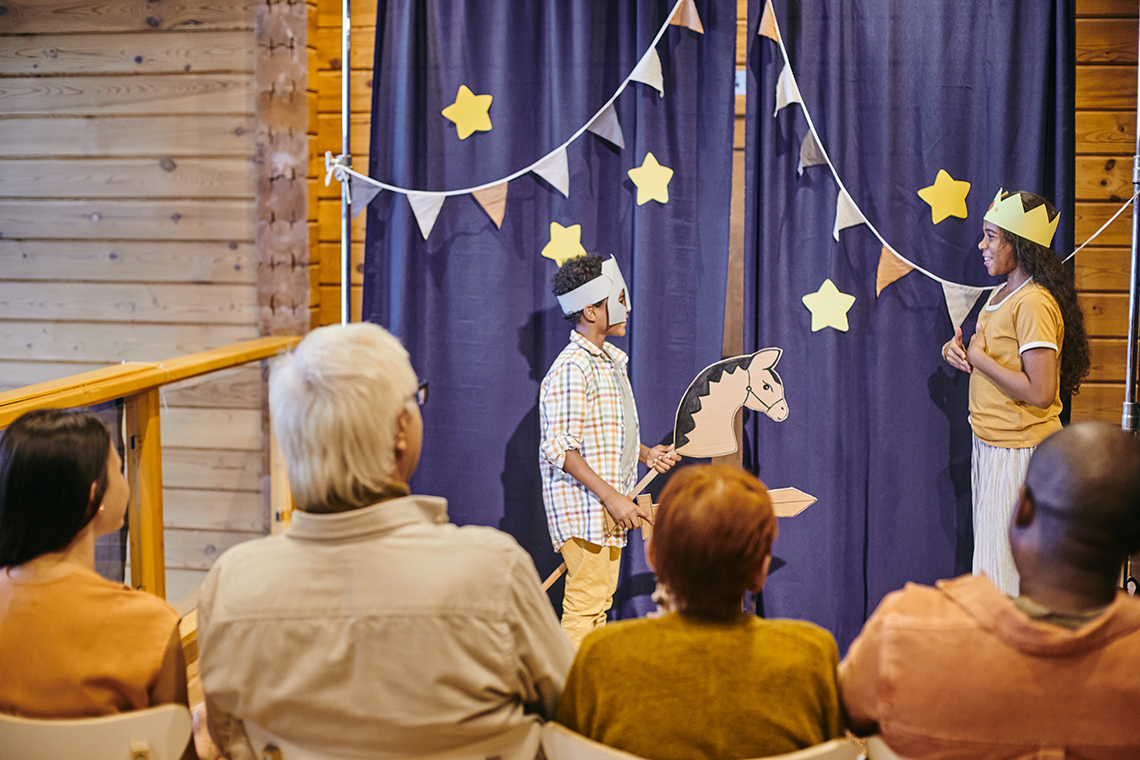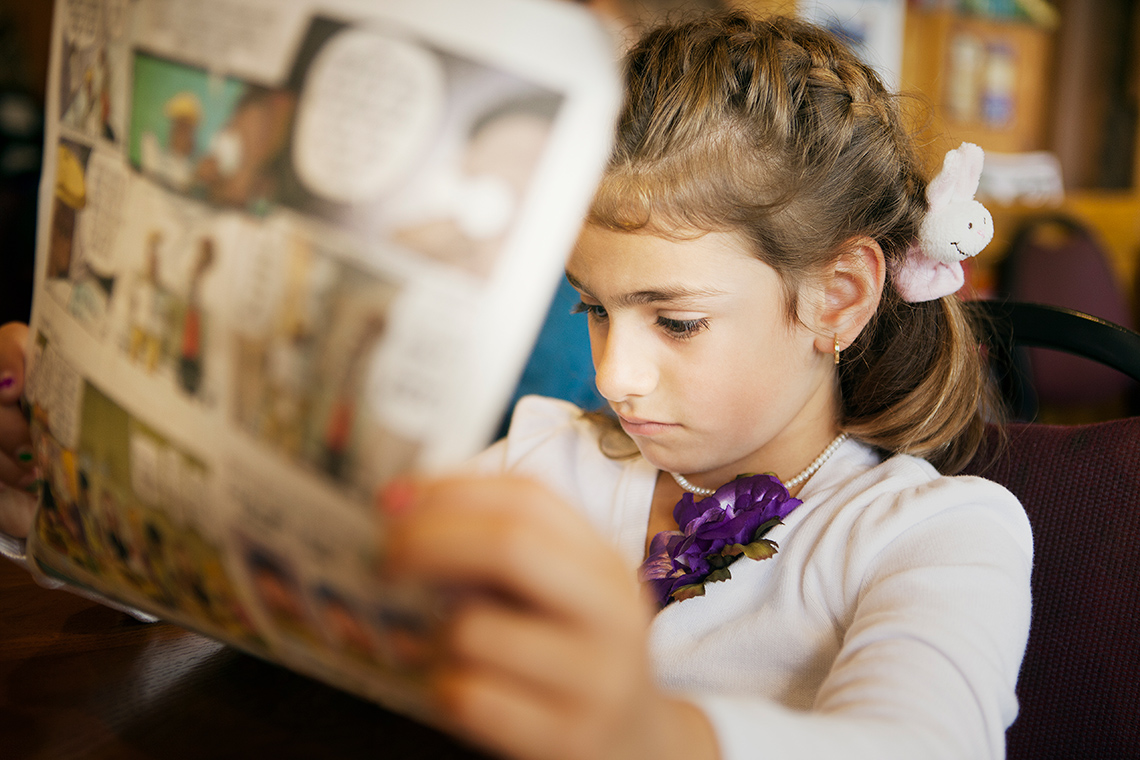Minds On
Warm up

Don’t forget to do your safety check!
Warm Up
Breathe in and out
For our warm-up activity, access this audio clip entitled “Breathing Activity” to learn more about taking deep breaths.
Breathing Activity
Find a comfortable position. Focus your attention on one part of the body at a time.
How does that part of your body feel? If possible, take a deep breath and allow your lungs to expand.
Now, focus your attention on one part of your body. Allow that part to relax before moving on to the next.
As you scan through your body, keep breathing deeply.
Once you have completed the scan, take a moment to stretch.
Drama game

Imagine that you are a tree, beginning life as a seed pod.
Explore the following audio and visualize, move, or just explore the process of growing through the seasons in your own way.
Access this audio clip entitled “Tree” to learn more about the tree game.
Tree
Imagine that you are an apple seed, tight in your seed pod, tucked in the ground. It is winter and you are still very sleepy.
Now it is spring. You start to feel a little more awake. You wiggle your body from side to side. The earth feels warmer because of the sun.
It’s time for you to come out of your seed pod. You push against your seed pod and break through. This is like when a bird breaks out of its shell. You wiggle your body some more and take a big stretch, reaching upwards towards the sun.
The sun gives you energy. You start to feel strong. You stretch upwards with your body, stretching your body upwards. You are a healthy seedling, continuing to grow.
Stretch up even further as you grown into a strong young tree. You have beautiful branches with green leaves that flutter in the wind.
Fall comes and your leaves begin to fall. One by one they slowly fall until your branches are bare. But you know you will grow more next spring. Now winter comes and that means that it’s time to rest. You relax your body and wait for spring.
After the game, reflect on your experience with the following questions:
- How did you feel when you grew out of the seed pod?
- What was it like when you first experienced the sun?
- How did it feel in role as the growing tree? Did you feel strong? Powerful? Vulnerable?
Share your thoughts with a partner, if possible.

Student Success
Think-Pair-Share
Think about your favourite moment or part of a drama story, production, or a video.
- What about it captures your attention?
- Why do you like it?
- Does the moment teach the character or the audience a particular lesson?
Record your ideas in a notebook or another method of your choice.
Then, share your thoughts with a partner, if possible.
Action
Get ready, get set…

In the Minds On section, we explored a specific moment or part in a drama story, production, or video. In drama, this is called a scene.
A scene is a part of a story at a specific time and place, involving one or many characters.
The Debajehmujig Theatre Group
Drama is based in the tradition of storytelling. Communities have been engaging in storytelling for centuries. It is part of oral tradition.
Elders and Knowledge Keepers from Indigenous communities play an important role in preserving and passing on their histories, traditions, teachings, and knowledge from one generation to the next. Each nation has its own story about how the world and its people, clans, governance, traditions, and more were created. These are not “myths” or “legends,” rather they are called creation stories. Some stories are only told to particular people or in particular settings. Furthermore, some stories are protected and are only told within the community.
The Debajehmujig Theatre Group is an important community theatre found in Ontario. They share stories through the use of different drama techniques
Press the following tabs to learn more about the work of the Debajehmujig Theatre Group.
On Manitoulin Island, in Northern Ontario sits an Indigenous theatre company called Debajehmujig Theatre Group. This was the first, and still remains the only, professional theatre company located in a First Nations community in Canada.
In 1984, in West Bay, at M’Chigeeng First Nation, Shirlee Cheechoo and Blake Debassige, together with friends and colleagues came together to found this community theatre. In 1989, they brought it to Wikwemikong, a First Nation reserve, where their headquarters is still found today.
This community theatre creates pieces that reflect Anishinaabeg/Chippewa Nation worldview. It supports and promotes Indigenous artists, both on and behind the stage. Its goal is to share the theme of creation with our whole being, which includes our emotional, physical, intellectual, and spiritual selves.
Through the art of storytelling, this community theatre shares Indigenous stories that have been passed down for thousands of years through storytelling, music, and dancing.
‘De-ba-jeh-mu-jig’ means ‘storytellers’ in the Cree and Ojibwe language.
Source: debaj.ca
The Three Sisters
This video was created by the Debajehmujig Storytellers that tells the story of The Three Sisters, the origin of the traditional Oneida diet.
Did You Know?
Did you know?
The Oneida have a long, rich history and are one of the Six Nations that form the Haudenosaunee Confederacy. Haudenosaunee means “The People of the Longhouse” and includes the Mohawk, Oneida, Onondaga, Cayuga, Seneca and Tuscarora nations. Today, there are two Oneida communities in Ontario (Six Nations and the Oneida of the Thames), one in Wisconsin (Oneida Nation of Wisconsin) and another community in New York State (The Oneida Indian Nation). The Three Sisters were vital to Haudenosaunee sustenance and survival.
Source: https://oneida-nsn.gov
Explore this video entitled “The Three Sisters” to review the story as performed by Kitty Lynn Lickers.
After exploring the video, reflect on the following questions: :
- How might the storyteller have prepared for their performance?
- What kind of effects did the performance include to engage the audience?
Press ‘Possible Answer’ to discover how the storytellers may have prepared for their performance and included different effects.
The storyteller might have read the story, researched its significance, and worked with others to create visuals and music to accompany the story. They may have practised varying their tone of voice.
The performance included visuals and music to engage the audience.
Record your ideas in a notebook or another method of your choice.
Share your thoughts with a partner, if possible.
Scene analysis

Next, let’s examine the following scene from the film.
While exploring the scene, consider how we might use the elements of drama to analyze how the scene was created.
Press ‘Elements of Drama’ to explore the definitions for each element of drama.
Focus or Emphasis: We can create focus or emphasis through introducing a main idea, theme, or problem in a drama.
Relationship(s): Relationships between characters can be shared through the way that characters speak and behave with other characters in a drama. A character might also have a relationship to a place, and shares this through their actions or words (i.e., monologue).
Tension: Tension is a feeling the audience experiences. It can be created by including a problem in a drama that needs to be solved.
After checking out the scene, analyze each of the drama elements.
Complete the Scene Analysis - Drama Elements Activity in your notebook or using the following fillable and printable document. If you would like, you can use speech-to-text or audio recording tools to record your thoughts. Consider adding your work to your drama portfolio.
| Respond to the following questions to analyze each drama element presented in the explored scene of The Three Sisters. | |
|---|---|
|
Character What are the characters doing in this scene? Why might this moment be significant? Why might this moment be significant? |
Focus and emphasis What is the main idea or problem in this scene? |
|
Time and Place What do you notice about the setting of the scene? Does it change? |
Relationship What kind of relationship(s) is explored in this scene? |
|
Tension Does this scene use sound, visuals and/or in specific ways? If so, how effectively did it help create a particular mood? Does this scene include drama conventions? How are they used? In what other ways is tension created? |
|
Press the ‘Activity’ button to access Scene Analysis - Drama Elements Activity.
When you’re ready, press ‘Let’s Check!’ to access possible responses.
|
Character What are the characters doing in this scene? Why might this moment be significant? Possible response: In the beginning of this scene, the last sister mourns the loss of her two other sisters. When the Odawa boy arrives, he picks her up and brings her to his home. This is significant as it sets up the final scene where the sisters are reunited. |
Focus and emphasis What is the main idea or problem in this scene? Possible response: This scene focuses on the third sister who is the only one that remains in the field. |
|
Time and place What do you notice about the setting of the scene? Does it change? Possible response: |
Relationship What kind of relationship(s) is explored in this scene? Possible response: This scene explores the relationship between the sisters. It also explores the relationship between the little Odawa boy and the corn sister. He is the only one that hears her crying and helps her. |
|
Tension Does this scene use sound, visuals and/or in specific ways? If so, how effectively did it help create a particular mood? In what ways is tension created? Possible response: Tension is created by contrasting this sad moment for the last sister narrated by Kitty Lynn Lickers with the calm, soothing music. The first visual is of the third sister in the field. Tension is later created in the scene as the Odawa boy takes the sister from the field. This is represented in the second visual of the scene. The music remains the same, but the audience must wait to know what will happen to the third sister. |
|
Pause and Reflect
Pause and reflect
Do you connect with this scene? Why or why not?
Record your ideas in a notebook or another method of your choice.
Go!
Try It
Your turn!

Select a scene from your favourite drama performance or production. You may also select another scene you enjoyed from The Three Sisters.
Use the elements of drama to guide an analysis of the scene.
Drama elements
Press the following tabs to explore each drama element.
- Who are the characters in the scene?
- What does the audience learn about the character(s) from their lines, gestures, and/or movements in this scene?
- What is the main idea or problem in this scene?
- Does the scene use a drama convention (e.g., tableax, narration, soundscape, etc.) to help the audience understand the character(s) emotions, perspectives, and ideas?
- What is the setting in this scene?
- Is the setting explored by the character(s)?
- Does the setting have a specific significance?
- Is there a relationship explored in this scene?
- If so, how is it explored?
Hint: There could be a relationship between characters, or between the character and their environment.
- Is sound, light, staging, and/or technology used to create a particular mood?
- If so, what kind of mood is created (e.g., suspenseful, joyful, sad, etc.)?
Consolidation
Scene review

Let’s review!
You have been asked to do a review of the film The Three Sisters, or a film/drama production of your choice for a local newspaper.
Use the explored questions and responses from the Action section to help create a review. Additionally, answer the following questions:
- Title: What is the title of the film?
- Performers: Who performs the story?
- Characters: Who are the characters in the story? Are there main characters and secondary characters?
- Time and place: What is the setting at the beginning of the performance? Does the setting change throughout the performance?
- What is the time period? What kind of clues does the performance provide to help you know that?
- Plot: Describe the sequence of events at the beginning, middle, and end of the story. Is there a problem and resolution?
- Plot: Describe the sequence of events at the beginning, middle, and end of the film.
- Message of the story: What is the main message, moral, or lesson of the story?
- Favourite scene: Which is your favourite scene? Why?
Complete the My Review Activity in your notebook or using the following fillable and printable document. If you would like, you can use speech-to-text or audio recording tools to record your thoughts. Consider adding your work to your drama portfolio.
| Title: | |
| Characters | Plot
Beginning: Middle: Problem: Resolution: End: |
| Time and Place | |
| Message/lesson/morale: | |
| Favourite scene: | |
Press the ‘Activity’ button to access My Review Activity.
Portfolio
Review your learning
Reflect on the following questions:
- What kind of effects were used in the performance of The Three Sisters by the Debajehmujig Storytellers?
- Do you feel that these effects were used effectively? Why or why not?
- What are some of your main learnings around scene development?
Record your ideas in a notebook or another method of your choice.
Consider adding your work to your drama portfolio.
Reflection
As you read through these descriptions, which sentence best describes how you are feeling about your understanding of this learning activity? Press the button that is beside this sentence.
I feel…
Now, record your ideas using a voice recorder, speech-to-text, or writing tool.